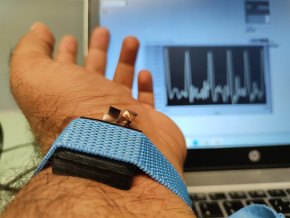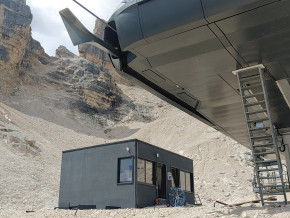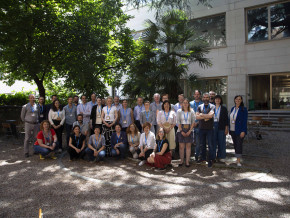New winter mountaineering project for Simone Moro and Tamara Lunger
A Eurac Research study on acclimatisation and de-acclimatisation will take place in the terraXcube centre for the simulation of extreme climates.
Internationally renowned, especially for his extreme winter climbs, mountaineer Simone Moro, and Tamara Lunger, one of the world's strongest high-altitude climbers, announce the destination of their next expedition. In mid-December they will attempt the ascent to the summit of Gasherbrum I and the traverse to Gasherbrum II - two mountains above the eight thousand metre mark that form part of the Karakorum chain in the Himalayas.
Artificial acclimatisation will take place inside terraXcube, Eurac research´s center for the simulation of extreme climates situated within NOI Techpark Südtirol/Alto Adige. Within these parameters, physiologists and doctors from Eurac Research will investigate the subjects acclimatisation in the hypobaric chamber and monitor their de-acclimatisation once Tamara and Simone have returned from the actual expedition. Observing for example the impacts of high altitude on the heart, respiratory, cognitive and metabolic functions and recording how long the body remains acclimatised once it has returned to a base altitude.
"In the summer of 1984, Reinhold Messner and Hans Kammerlander succeeded for the first time in the ascent and crossing of Gasherherbrum I (8,068m) and Gasherbrum II (8,035m). On the 35th anniversary of this extraordinary achievement, we want to repeat the adventure and raise the bar on it: Daring both eight-thousand metre peaks including the crossing as a winter expedition," says Simone Moro. "No one has ever repeated this undertaking, not even in the summer. Our experience with winter walks will definitely be helpful.”

Their acclimatisation within the terraXcube will last in all, about four weeks. After initial medical checks, in the first phase (currently in progress) Tamara and Simone sleep inside terraXcube´s hypobaric chamber at night and train outside during the day. Over the next two weeks Tamara and Simone will remain more or less continuously inside the hypobaric chamber, where they can train on a treadmill. The goal is to achieve a good acclimatisation of up to about 6400m. Providing that Simone and Tamara are able to cope and with these conditions i.e. have no symptoms of discomfort, and are sleeping and eating well, the researchers will (for a few hours) take the room to even higher altitudes, up to 8000m and beyond. The temperature will also undergo changes to observe the adaptation of the body to the cold. During this period, the tests already carried out at the beginning of the study will be repeated regularly.
"This is an opportunity for us to monitor two subjects in a perfectly controlled and controllable context, that is, in the climate chamber of terraXcube. A deeper understanding of how physiology reacts to hypoxia, (the lack of oxygen at altitude) could not only signify improvements in the safety of mountaineering expeditions, but also in the conditions of those who work at high altitudes; rescue teams, humanitarian missions (for example those undertaken following the earthquake in Nepal) and also for workers engaged in the construction of roads or dams" explains Hermann Brugger, Head of Eurac Research’s Institute for Emergency Mountain Medicine. "Not only that, this case study will help to understand on which aspects to focus attention for future research following which, studies can then be enlarged to a greater number of participants in order to provide greater statistical relevance."
terraXcube is a new infrastructure and this project is a great test bed, of this, Stephan Ortner, director of Eurac Research, and Christian Steurer, director of terraXcube, are convinced: "Simone and Tamara are mountaineers in extraordinary peak physical condition. This study signifies the perfect combination of parameters for the fine-tuning of interaction between humans and technology in the extreme conditions of the terraXcube. With no one else would it be possible to carry out certain tests for the first time, such as taking the chamber up to 8000m."

Stages of the study
a) Before: Preparation for entering the chamber. The researchers recorded Simone and Tamara´s physiological values before starting the process. Both underwent various tests including magnetic resonance (with the support of the CIMeC Trento), blood tests, pulmonary and optic nerve ultrasound, ECG and cardiac ultrasound. Measurements of sublingual microcirculation were also recorded. These serve as the base values for comparison purposes and are used to measure the effect of acclimatisation during their residence in the chamber.
b) During: Acclimatisation within the terraXube. Phase 1: In the first two weeks, from November 16th, in the evening Tamara and Simone will sleep inside the terraXcube hypobaric chamber and train outside during the day. Phase 2: In the following two weeks, from November 29th Tamara and Simone, will remain more or less continuously inside the hypobaric chamber, where they will be able to train on a treadmill. The goal is to reach acclimatisation of up to 6400m. Providing that Simone and Tamara are able to cope and with these conditions, experience no discomfort and are able to sleep and eat well, the researchers will then bring the chamber to even higher altitudes, up to and exceeding 8000m. The chamber´s internal temperature will be lowered in order to observe the body´s adaptation to the cold. Throughout this phase the tests previously undertaken will be repeated regularly. Tamara and Simone will continuously be wearing an Equivital device, a type of harness worn close to skin that serves both to collect data on their vital functions such as heart rate, temperature and respiratory rate, and to ensure their safety inside the chamber.
c) After: Upon return from the expedition. On their return from the expedition, Tamara and Simone will regularly be subjected to the same rigorous examinations, until the values have returned to those initially recorded in order to understand the duration and development of the acclimatisation.
Related Articles

Tecno-prodotti. Creati nuovi sensori triboelettrici nel laboratorio di sensoristica al NOI Techpark
I wearable sono dispositivi ormai imprescindibili nel settore sanitario e sportivo: un mercato in crescita a livello globale che ha bisogno di fonti di energia alternative e sensori affidabili, economici e sostenibili. Il laboratorio Sensing Technologies Lab della Libera Università di Bolzano (unibz) al Parco Tecnologico NOI Techpark ha realizzato un prototipo di dispositivo indossabile autoalimentato che soddisfa tutti questi requisiti. Un progetto nato grazie alla collaborazione con il Center for Sensing Solutions di Eurac Research e l’Advanced Technology Institute dell’Università del Surrey.

unibz forscht an technologischen Lösungen zur Erhaltung des Permafrostes in den Dolomiten
Wie kann brüchig gewordener Boden in den Dolomiten gekühlt und damit gesichert werden? Am Samstag, den 9. September fand in Cortina d'Ampezzo an der Bergstation der Sesselbahn Pian Ra Valles Bus Tofana die Präsentation des Projekts „Rescue Permafrost " statt. Ein Projekt, das in Zusammenarbeit mit Fachleuten für nachhaltiges Design, darunter einem Forschungsteam für Umweltphysik der unibz, entwickelt wurde. Das gemeinsame Ziel: das gefährliche Auftauen des Permafrosts zu verhindern, ein Phänomen, das aufgrund des globalen Klimawandels immer öfter auftritt. Die Freie Universität Bozen hat nun im Rahmen des Forschungsprojekts eine erste dynamische Analyse der Auswirkungen einer technologischen Lösung zur Kühlung der Bodentemperatur durchgeführt.

Gesunde Böden dank Partizipation der Bevölkerung: unibz koordiniert Citizen-Science-Projekt ECHO
Die Citizen-Science-Initiative „ECHO - Engaging Citizens in soil science: the road to Healthier Soils" zielt darauf ab, das Wissen und das Bewusstsein der EU-Bürger:innen für die Bodengesundheit über deren aktive Einbeziehung in das Projekt zu verbessern. Mit 16 Teilnehmern aus ganz Europa - 10 führenden Universitäten und Forschungszentren, 4 KMU und 2 Stiftungen - wird ECHO 16.500 Standorte in verschiedenen klimatischen und biogeografischen Regionen bewerten, um seine ehrgeizigen Ziele zu erreichen.

Erstversorgung: Drohnen machen den Unterschied
Die Ergebnisse einer Studie von Eurac Research und der Bergrettung Südtirol liegen vor.
